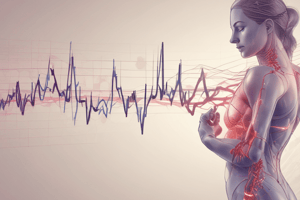Podcast
Questions and Answers
What formula is used to calculate Cardiac Output (CO)?
What formula is used to calculate Cardiac Output (CO)?
Which statement is true regarding Heart Rate (HR) classifications?
Which statement is true regarding Heart Rate (HR) classifications?
How does increased preload affect stroke volume according to the Frank-Starling Law?
How does increased preload affect stroke volume according to the Frank-Starling Law?
What role do positive chronotropic agents play in heart function?
What role do positive chronotropic agents play in heart function?
Signup and view all the answers
What effect does the sympathetic nervous system have on heart rate under normal conditions?
What effect does the sympathetic nervous system have on heart rate under normal conditions?
Signup and view all the answers
How do baroreceptors respond to an increase in blood pressure?
How do baroreceptors respond to an increase in blood pressure?
Signup and view all the answers
What is the consequence of increased afterload on stroke volume?
What is the consequence of increased afterload on stroke volume?
Signup and view all the answers
Which agent is known to be a positive inotropic agent that increases contractility?
Which agent is known to be a positive inotropic agent that increases contractility?
Signup and view all the answers
Study Notes
Cardiac Output (CO)
- CO is the volume of blood pumped by the heart per minute.
- Calculated using the formula: CO = Stroke Volume (SV) × Heart Rate (HR).
Heart Rate (HR)
- HR is measured in beats per minute (bpm).
- Intrinsic heart rate is approximately 100 bpm, but a typical resting HR for adults is 70-80 bpm.
- Tachycardia occurs when HR exceeds 100 bpm.
- Bradycardia is when HR falls below 60 bpm.
Chronotropic Agents
- Chemicals influencing heart rate:
- Positive Chronotropic Agents: Increase HR.
- Negative Chronotropic Agents: Decrease HR.
Autonomic Nervous System Control
- Parasympathetic Nervous System:
- Dominates during rest, reduces HR via vagus nerve and acetylcholine.
- Opens potassium channels, slowing depolarization.
- Sympathetic Nervous System:
- Increases HR using norepinephrine on beta-1 adrenergic receptors.
- Enhances sodium and calcium channel activity, facilitating faster depolarization.
Baroreceptor Reflex
- Baroreceptors in the aortic arch and carotid arteries monitor blood pressure.
- Increased blood pressure triggers more action potentials, resulting in:
- Increased parasympathetic output → Decreased HR → Lower CO → Lower arterial pressure.
- Decreased blood pressure results in:
- Fewer action potentials → Increased sympathetic output → Increased HR → Higher CO → Higher arterial pressure.
Stroke Volume (SV) Factors
- Preload:
- Volume of blood returning to the heart (end-diastolic volume).
- Increased preload enhances stroke volume (Frank-Starling Law).
- Contractility:
- The strength of ventricular contraction affects SV.
- Positive inotropic agents (e.g., norepinephrine) improve contractility by enhancing calcium influx.
- Afterload:
- The pressure the heart works against to eject blood (aortic pressure).
- Higher afterload (e.g., in hypertension) can reduce stroke volume by complicating aortic valve opening.
Summary of Effects on Heart Function
- Increased preload results in a higher stroke volume.
- Enhanced contractility leads to increased stroke volume.
- Elevated afterload can decrease stroke volume and overall cardiac output.
Conclusion
- Effective maintenance of blood pressure involves a balance of heart rate, stroke volume, and the resistance the heart pumps against.
- Understanding these dynamics is essential for cardiovascular health management and physiological adaptation.
Studying That Suits You
Use AI to generate personalized quizzes and flashcards to suit your learning preferences.
Description
This quiz covers the concepts of cardiac output and heart rate, including their definitions, calculations, and the factors that influence them. Explore the effects of autonomic nervous system control on heart rate, as well as the roles of chronotropic agents and the baroreceptor reflex. Test your understanding of cardiovascular physiology and its mechanisms.





